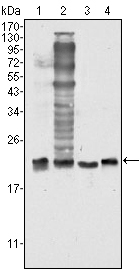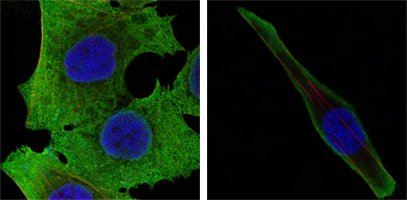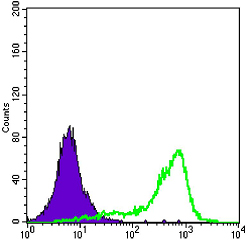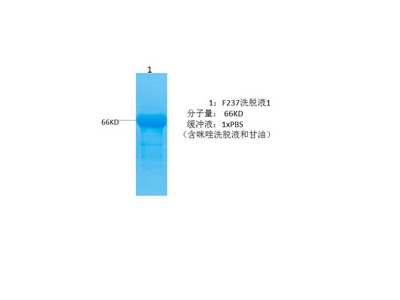SOD-1 Monoclonal Antibody
- Catalog No.:YM0590
- Applications:WB;IF;FCM;ELISA
- Reactivity:Human;Mouse
- Target:
- SOD-1
- Fields:
- >>Peroxisome;>>Longevity regulating pathway - multiple species;>>Parkinson disease;>>Amyotrophic lateral sclerosis;>>Huntington disease;>>Prion disease;>>Pathways of neurodegeneration - multiple diseases;>>Chemical carcinogenesis - reactive oxygen species
- Gene Name:
- SOD1
- Protein Name:
- Superoxide dismutase [Cu-Zn]
- Human Gene Id:
- 6647
- Human Swiss Prot No:
- P00441
- Mouse Gene Id:
- 20655
- Mouse Swiss Prot No:
- P08228
- Immunogen:
- Purified recombinant fragment of human SOD-1 expressed in E. Coli.
- Specificity:
- SOD-1 Monoclonal Antibody detects endogenous levels of SOD-1 protein.
- Formulation:
- Liquid in PBS containing 50% glycerol, 0.5% BSA and 0.02% sodium azide.
- Source:
- Monoclonal, Mouse
- Dilution:
- WB 1:500 - 1:2000. IF 1:200 - 1:1000. Flow cytometry: 1:200 - 1:400. ELISA: 1:10000. Not yet tested in other applications.
- Purification:
- Affinity purification
- Storage Stability:
- -15°C to -25°C/1 year(Do not lower than -25°C)
- Other Name:
- SOD1;Superoxide dismutase [Cu-Zn];Superoxide dismutase 1;hSod1
- Molecular Weight(Da):
- 16kD
- References:
- 1. Apoptosis. 2005 May;10(3):499-502.
2. Hum Mol Genet. 2008 Nov 1;17(21):3303-17.
- Background:
- The protein encoded by this gene binds copper and zinc ions and is one of two isozymes responsible for destroying free superoxide radicals in the body. The encoded isozyme is a soluble cytoplasmic protein, acting as a homodimer to convert naturally-occuring but harmful superoxide radicals to molecular oxygen and hydrogen peroxide. The other isozyme is a mitochondrial protein. Mutations in this gene have been implicated as causes of familial amyotrophic lateral sclerosis. Rare transcript variants have been reported for this gene. [provided by RefSeq, Jul 2008],
- Function:
- catalytic activity:2 superoxide + 2 H(+) = O(2) + H(2)O(2).,cofactor:Binds 1 copper ion per subunit.,cofactor:Binds 1 zinc ion per subunit.,disease:Defects in SOD1 are the cause of amyotrophic lateral sclerosis type 1 (ALS1) [MIM:105400]. ALS1 is a familial form of amyotrophic lateral sclerosis, a neurodegenerative disorder affecting upper and lower motor neurons and resulting in fatal paralysis. Sensory abnormalities are absent. Death usually occurs within 2 to 5 years. The etiology of amyotrophic lateral sclerosis is likely to be multifactorial, involving both genetic and environmental factors. The disease is inherited in 5-10% of cases leading to familial forms.,function:Destroys radicals which are normally produced within the cells and which are toxic to biological systems.,miscellaneous:The protein (both wild-type and ALS1 variants) has a tendency to form fibrillar aggregates in the
- Subcellular Location:
- Cytoplasm . Mitochondrion . Nucleus . Predominantly cytoplasmic; the pathogenic variants ALS1 Arg-86 and Ala-94 gradually aggregates and accumulates in mitochondria. .
- Expression:
- Colon,Fetal brain cortex,Placenta,
JSH-23 prevents depressive-like behaviors in mice subjected to chronic mild stress: Effects on inflammation and antioxidant defense in the hippocampus. PHARMACOLOGY BIOCHEMISTRY AND BEHAVIOR Pharmacol Biochem Be. 2018 Jun;169:59 WB Mouse 1:500 Hippocampal
- June 19-2018
- WESTERN IMMUNOBLOTTING PROTOCOL
- June 19-2018
- IMMUNOHISTOCHEMISTRY-PARAFFIN PROTOCOL
- June 19-2018
- IMMUNOFLUORESCENCE PROTOCOL
- September 08-2020
- FLOW-CYTOMEYRT-PROTOCOL
- May 20-2022
- Cell-Based ELISA│解您多样本WB检测之困扰
- July 13-2018
- CELL-BASED-ELISA-PROTOCOL-FOR-ACETYL-PROTEIN
- July 13-2018
- CELL-BASED-ELISA-PROTOCOL-FOR-PHOSPHO-PROTEIN
- July 13-2018
- Antibody-FAQs
- Products Images

- Western Blot analysis using SOD-1 Monoclonal Antibody against HeLa (1), NIH/3T3 (2), A549 (3) and A431 (4) cell lysate.

- Confocal immunofluorescence analysis of PANC-1 (left) and SKBR-3 (right) cells using SOD-1 Monoclonal Antibody (green). Red: Actin filaments have been labeled with DY-554 phalloidin. Blue: DRAQ5 fluorescent DNA dye.

- Flow cytometric analysis of A431 cells using SOD-1 Monoclonal Antibody (green) and negative control (purple).

